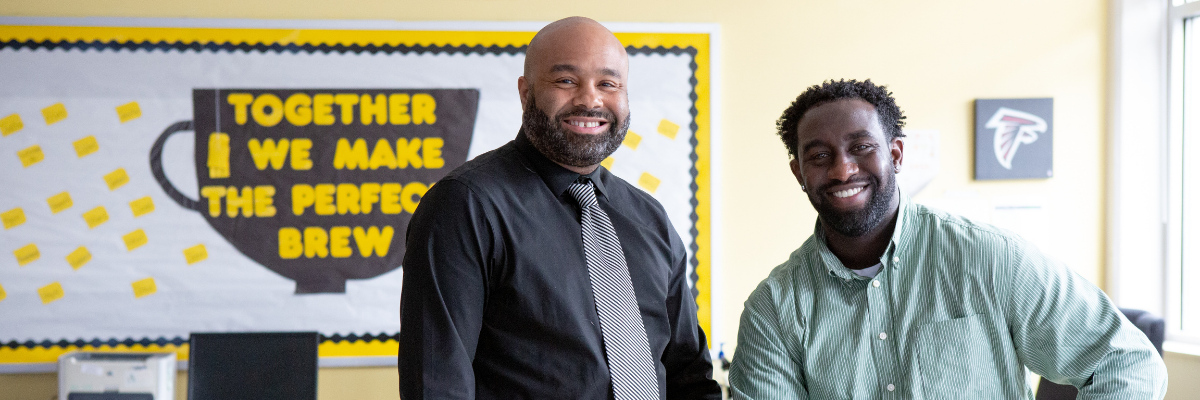While it may still feel like the 273rd day of March, we're really truly nearing the end of December, and the year 2020. As the days grow shorter and the shadows longer, it's tempting to dwell on all the darkness of this year. The friends and family we've missed breaking bread with—only temporarily, if we're among the lucky ones. The ongoing struggle to convince many white Americans that Black lives really do matter. The financial hardships for many who have lost jobs. The lost months of learning and worsening opportunity gaps.
But it's also been a year for taking stock of what we have, for recognizing all that is good in the lives we used to consider mundane, the habits we took for granted. This darkness has allowed rays of sun to shine through that much more brightly.
One of those rays of light has settled on our nation's teacher workforce. The teachers still working from their dining tables have had to learn an entirely new way of teaching, while keeping students engaged despite the swirl of worries surrounding everyone. The teachers going back to the classrooms are risking their own health to serve their students. The challenges our teachers are facing are enormous, yet they are showing up day after day to help their students build a brighter future.
And in that spirit, we devote our last Teacher Quality Bulletin of 2020 to focusing on the light, to finding the silver linings in this year's research on teacher quality.

Reinvest in student teaching! It's a low cost, high impact way to improve the quality of new teachers.
Nearly every teacher prep program in the country already has a student teaching requirement, and the research is clear that with a few tweaks, they can build a stronger teacher workforce. Student teaching is the best opportunity teacher candidates have to put all of their learning into practice, as they spend weeks in a classroom with a mentor teacher, and is consistently identified as the most valuable part of their teacher preparation experience.
There's been a lot of new research from the last year illustrating the many ways that student teaching can help support a strong teacher workforce.
Districts looking to hire more teachers can solve shortages by planning ahead and hosting more student teachers. Districts can address one of the toughest shortage areas—special education—by identifying student teachers who are working on a dual endorsement and assigning them to a mentor teacher who has a special ed certification. With that kind of student teaching experience, they're more likely to take a special education job.
The most significant finding this year, in our view, is that novice teachers can start their career as effective as a typical third-year teacher if they were assigned to a highly effective mentor teacher. That finding should prod every school district in the nation to take student teaching assignments more seriously. Further, that great mentor teacher needn't worry about taking on the student teacher as there's no evidence of a decline in student learning or a lower evaluation score from hosting a student teacher.

Teachers can beat their biases.
Biases are difficult to overcome, with little evidence that professional development and anti-bias trainings change people's behavior or implicit biases. But, changes to grading habits can mitigate effects of bias. School districts, teacher prep programs, or even individual teachers, can create detailed, explicit grading rubrics that can help ensure that students' work is graded on its merits and is not unduly influenced by prejudice. This finding has exciting implications. While researchers continue to work to find ways to actually change or surface teachers' implicit biases, schools can and should put in place protocols for grading, calling on students, and choosing line leaders that reduce the opportunity for bias to play a prominent role in decision making.

A Black teacher's impact ripples beyond her classroom.
While there are not enough Black teachers in classrooms, each one can make an enormous difference for their Black students - even ones they don't teach. Prior research has demonstrated that a student who has one Black teacher in the elementary years is more likely to finish high school and even go to college. Add to that a new study in 2020 finding that in upper grades, Black students are more likely to choose to take advanced courses when they see advanced courses being taught by Black teachers.

Teacher evaluations may help keep effective teachers in the classroom.
Teacher evaluations can be a powerful tool to give teachers guidance and support, but some worry that receiving an evaluation rating may drive some teachers out of the profession. A meta-analysis finds that in fact, teacher evaluations may be a tool for retention, specifically for the most effective teachers. While the authors of this research don't go into the reasons why, it's clear that teachers want to stay in jobs where they feel their hard work is supported and recognized.

Teacher candidates are receiving better preparation.
Teacher prep programs have had to "build the plane while flying" just like all other educators during this pandemic. But even before COVID shook things up, prep programs have made great strides in two essential areas: teaching scientifically-based reading instruction and ensuring candidates practice key classroom management strategies. NCTQ reported a 33% increase in programs teaching the most effective methods of reading instruction and a 26% increase in programs expecting their teacher candidates to demonstrate knowledge of evidence-based classroom management strategies.
.png)
Existing tools can help predict who will be an effective teacher.
Perusing past research on teacher quality, one is struck by the titles bemoaning that there's no good way to predict who will be an effective teacher before they're in the classroom—which is bad news for students. But new research finds that licensure tests are positively correlated with teacher effectiveness, as measured by both value-added measures and teacher evaluation ratings. No measure is perfect, but this makes the case that licensure tests offer value as a guardrail, ensuring that teachers enter with the skills and knowledge they'll need, and perhaps as a bit of a crystal ball.
